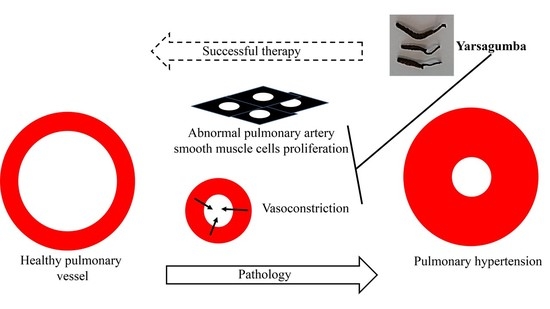Yarsagumba is a Promising Therapeutic Option for Treatment of Pulmonary Hypertension due to the Potent Anti-Proliferative and Vasorelaxant Properties
Abstract
1. Introduction
2. Materials and Methods
2.1. Preparation of Yarsagumba (Yarsa) Biomaterial
2.2. Ethics Approval and Consent to Participate
2.3. Isolated Murine Lungs
2.4. Cell isolation, Culture and Proliferation Assay
2.5. Data Analysis
3. Results
3.1. Yarsa Extract Reduced the Proliferation of hPASMCs
3.2. Cordycepin Reduced the Proliferation of hPASMCs
3.3. Yarsa Extract Showed Potent Vasodilatory Properties in Isolated Mouse Lungs
3.4. Cordycepin did not Show any Vasodilatory Properties in Isolated Mouse Lungs
4. Discussion
- (a)
- The application of the whole Yarsagumba extract resulted in significant reduction of hPASMCs proliferation and pulmonary vasodilatation in isolated, buffer-perfused and ventilated mice lungs.
- (b)
- With regard to cordycepin, an active biochemical agent isolated from Yarsagumba, there were also significant anti-proliferative effects on hPASMCs; however, the effects were less prominent in comparison to the whole extract of this parasitic fungus. Finally, there was no visible effect of cordycepin on pulmonary vasoconstriction.
5. Conclusions
Author Contributions
Funding
Acknowledgments
Conflicts of Interest
References
- Schermuly, R.T.; Ghofrani, H.A.; Wilkins, M.R.; Grimminger, F. Mechanisms of disease: Pulmonary arterial hypertension. Nat. Rev. Cardiol. 2011, 8, 443–455. [Google Scholar] [CrossRef] [PubMed]
- Schermuly, R.T.; Dony, E.; Ghofrani, H.A.; Pullamsetti, S.; Savai, R.; Roth, M.; Sydykov, A.; Lai, Y.J.; Weissmann, N.; Seeger, W.; et al. Reversal of experimental pulmonary hypertension by PDGF inhibition. J. Clin. Investig. 2005, 115, 2811–2821. [Google Scholar] [CrossRef] [PubMed]
- Dahal, B.K.; Kosanovic, D.; Pamarthi, P.K.; Sydykov, A.; Lai, Y.J.; Kast, R.; Schirok, H.; Stasch, J.P.; Ghofrani, H.A.; Weissmann, N.; et al. Therapeutic efficacy of azaindole-1 in experimental pulmonary hypertension. Eur. Respir. J. 2010, 36, 808–818. [Google Scholar] [CrossRef] [PubMed]
- Dahal, B.K.; Kosanovic, D.; Kaulen, C.; Cornitescu, T.; Savai, R.; Hoffmann, J.; Reiss, I.; Ghofrani, H.A.; Weissmann, N.; Kuebler, W.M.; et al. Involvement of mast cells in monocrotaline-induced pulmonary hypertension in rats. Respir. Res. 2011, 12, 60. [Google Scholar] [CrossRef]
- Kosanovic, D.; Dahal, B.K.; Peters, D.M.; Seimetz, M.; Wygrecka, M.; Hoffmann, K.; Antel, J.; Reiss, I.; Ghofrani, H.A.; Weissmann, N.; et al. Histological characterization of mast cell chymase in patients with pulmonary hypertension and chronic obstructive pulmonary disease. Pulm. Circ. 2014, 4, 128–136. [Google Scholar] [CrossRef]
- Savai, R.; Pullamsetti, S.S.; Kolbe, J.; Bieniek, E.; Voswinckel, R.; Fink, L.; Scheed, A.; Ritter, C.; Dahal, B.K.; Vater, A.; et al. Immune and inflammatory cell involvement in the pathology of idiopathic pulmonary arterial hypertension. Am. J. Respir. Crit. Care Med. 2012, 186, 897–908. [Google Scholar] [CrossRef]
- Bowers, R.; Cool, C.; Murphy, R.C.; Tuder, R.M.; Hopken, M.W.; Flores, S.C.; Voelkel, N.F. Oxidative stress in severe pulmonary hypertension. Am. J. Respir. Crit. Care Med. 2004, 169, 764–769. [Google Scholar] [CrossRef]
- Ghasemzadeh, N.; Patel, R.S.; Eapen, D.J.; Veledar, E.; Al Kassem, H.; Manocha, P.; Khayata, M.; Zafari, A.M.; Sperling, L.; Jones, D.P.; et al. Oxidative stress is associated with increased pulmonary artery systolic pressure in humans. Hypertension 2014, 63, 1270–1275. [Google Scholar] [CrossRef]
- Kosanovic, D.; Tian, X.; Pak, O.; Lai, Y.J.; Hsieh, Y.L.; Seimetz, M.; Weissmann, N.; Schermuly, R.T.; Dahal, B.K. Rhodiola: An ordinary plant or a promising future therapy for pulmonary hypertension? A brief review. Pulm. Circ. 2013, 3, 499–506. [Google Scholar] [CrossRef]
- Chakraborty, S.; Chowdhury, S.; Nandi, G. Review on Yarsagumba (Cordyceps sinensis)—An exotic medicinal mushroom. Int. J. Pharmacogn. Phytochem. Res. 2014, 6, 339–346. [Google Scholar]
- Seth, R.; Haider, S.Z.; Mohan, M. Pharmacology, phytochemistry and traditional uses of Cordyceps sinensis (Berk.) Sacc: A recent update for future prospects. Indian J. Tradit. Knowl. 2014, 13, 551–556. [Google Scholar]
- Huang, T.T.; Lai, H.C.; Ko, Y.F.; Ojcius, D.M.; Lan, Y.W.; Martel, J.; Young, J.D.; Chong, K.Y. Hirsutella sinensis mycelium attenuates bleomycin-induced pulmonary inflammation and fibrosis in vivo. Sci. Rep. 2015, 5, 15282. [Google Scholar] [CrossRef] [PubMed]
- Zhu, J.S.; Halpern, G.M.; Jones, K. The scientific rediscovery of an ancient Chinese herbal medicine: Cordyceps sinensis: Part I. J. Altern. Complement. Med. 1998, 4, 289–303. [Google Scholar] [CrossRef] [PubMed]
- Zhu, J.S.; Halpern, G.M.; Jones, K. The scientific rediscovery of a precious ancient Chinese herbal regimen: Cordyceps sinensis: Part II. J. Altern. Complement. Med. 1998, 4, 429–457. [Google Scholar] [CrossRef]
- Park, E.S.; Kang, D.H.; Yang, M.K.; Kang, J.C.; Jang, Y.C.; Park, J.S.; Kim, S.K.; Shin, H.S. Cordycepin, 3′-deoxyadenosine, prevents rat hearts from ischemia/reperfusion injury via activation of Akt/GSK-3beta/p70S6K signaling pathway and HO-1 expression. Cardiovasc. Toxicol. 2014, 14, 1–9. [Google Scholar] [CrossRef]
- Chiou, W.F.; Chang, P.C.; Chou, C.J.; Chen, C.F. Protein constituent contributes to the hypotensive and vasorelaxant activities of Cordyceps sinensis. Life Sci. 2000, 66, 1369–1376. [Google Scholar] [CrossRef]
- Chen, M.; Cheung, F.W.; Chan, M.H.; Hui, P.K.; Ip, S.P.; Ling, Y.H.; Che, C.T.; Liu, W.K. Protective roles of Cordyceps on lung fibrosis in cellular and rat models. J. Ethnopharmacol. 2012, 143, 448–454. [Google Scholar] [CrossRef]
- Xu, H.; Li, S.; Lin, Y.; Liu, R.; Gu, Y.; Liao, D. Effectiveness of cultured Cordyceps sinensis combined with glucocorticosteroid on pulmonary fibrosis induced by bleomycin in rats. Zhongguo Zhong Yao Za Zhi 2011, 36, 2265–2270. [Google Scholar]
- Liu, Q.; Zhang, W.; Cui, H.; Ying, Y. Study on effect of cordyceps sinensis on early-stage silicotic pulmonary fibrosis in rabbits. Zhonghua Lao Dong Wei Sheng Zhi Ye Bing Za Zhi. 2014, 32, 530–532. [Google Scholar]
- Wang, N.; Li, J.; Huang, X.; Chen, W.; Chen, Y. Herbal Medicine Cordyceps sinensis Improves Health-Related Quality of Life in Moderate-to-Severe Asthma. Evid. Based Complement. Alternat. Med. 2016, 2016, 6134593. [Google Scholar] [CrossRef]
- Tuli, H.S.; Sandhu, S.S.; Sharma, A.K. Pharmacological and therapeutic potential of Cordyceps with special reference to Cordycepin. 3 Biotech 2014, 4, 1–12. [Google Scholar] [CrossRef] [PubMed]
- Yang, X.; Li, Y.; He, Y.; Li, T.; Wang, W.; Zhang, J.; Wei, J.; Deng, Y.; Lin, R. Cordycepin alleviates airway hyperreactivity in a murine model of asthma by attenuating the inflammatory process. Int. Immunopharmacol. 2015, 26, 401–408. [Google Scholar] [CrossRef] [PubMed]
- Kim, H.; Naura, A.S.; Errami, Y.; Ju, J.; Boulares, A.H. Cordycepin blocks lung injury-associated inflammation and promotes BRCA1-deficient breast cancer cell killing by effectively inhibiting PARP. Mol. Med. 2011, 17, 893–900. [Google Scholar] [CrossRef] [PubMed]
- Rathor, R.; Mishra, K.P.; Pal, M.; Amitabh, S.; Vats, P.; Kirar, V.; Negi, P.S.; Misra, K. Scientific validation of the Chinese caterpillar medicinal mushroom, Ophiocordyceps sinensis (Ascomycetes) from India: Immunomodulatory and antioxidant activity. Int. J. Med. Mushrooms 2014, 16, 541–553. [Google Scholar] [CrossRef]
- Ramesh, T.; Yoo, S.K.; Kim, S.W.; Hwang, S.Y.; Sohn, S.H.; Kim, I.W.; Kim, S.K. Cordycepin (3′-deoxyadenosine) attenuates age-related oxidative stress and ameliorates antioxidant capacity in rats. Exp. Gerontol. 2012, 47, 979–987. [Google Scholar] [CrossRef]
- Chu, H.L.; Chien, J.C.; Duh, P.D. Protective effect of Cordyceps militaris against high glucose-induced oxidative stress in human umbilical vein endothelial cells. Food Chem. 2011, 129, 871–876. [Google Scholar] [CrossRef]
- Chang, W.; Lim, S.; Song, H.; Song, B.W.; Kim, H.J.; Cha, M.J.; Sung, J.M.; Kim, T.W.; Hwang, K.C. Cordycepin inhibits vascular smooth muscle cell proliferation. Eur. J. Pharmacol. 2008, 597, 64–69. [Google Scholar] [CrossRef]
- Jung, S.M.; Park, S.S.; Kim, W.J.; Moon, S.K. Ras/ERK1 pathway regulation of p27KIP1-mediated G1-phase cell-cycle arrest in cordycepin-induced inhibition of the proliferation of vascular smooth muscle cells. Eur. J. Pharmacol. 2012, 681, 15–22. [Google Scholar] [CrossRef]
- Gao, B.A.; Yang, J.; Huang, J.; Cui, X.J.; Chen, S.X.; Den, H.Y.; Xiang, G.M. Cordyceps sinensis extract suppresses hypoxia-induced proliferation of rat pulmonary artery smooth muscle cells. Saudi Med. J. 2010, 31, 974–979. [Google Scholar]
- Weissmann, N.; Hackemack, S.; Dahal, B.K.; Pullamsetti, S.S.; Savai, R.; Mittal, M.; Fuchs, B.; Medebach, T.; Dumitrascu, R.; Eickels, M.; et al. The soluble guanylate cyclase activator HMR1766 reverses hypoxia-induced experimental pulmonary hypertension in mice. Am. J. Physiol. Lung Cell. Mol. Physiol. 2009, 297, L658–L665. [Google Scholar] [CrossRef]
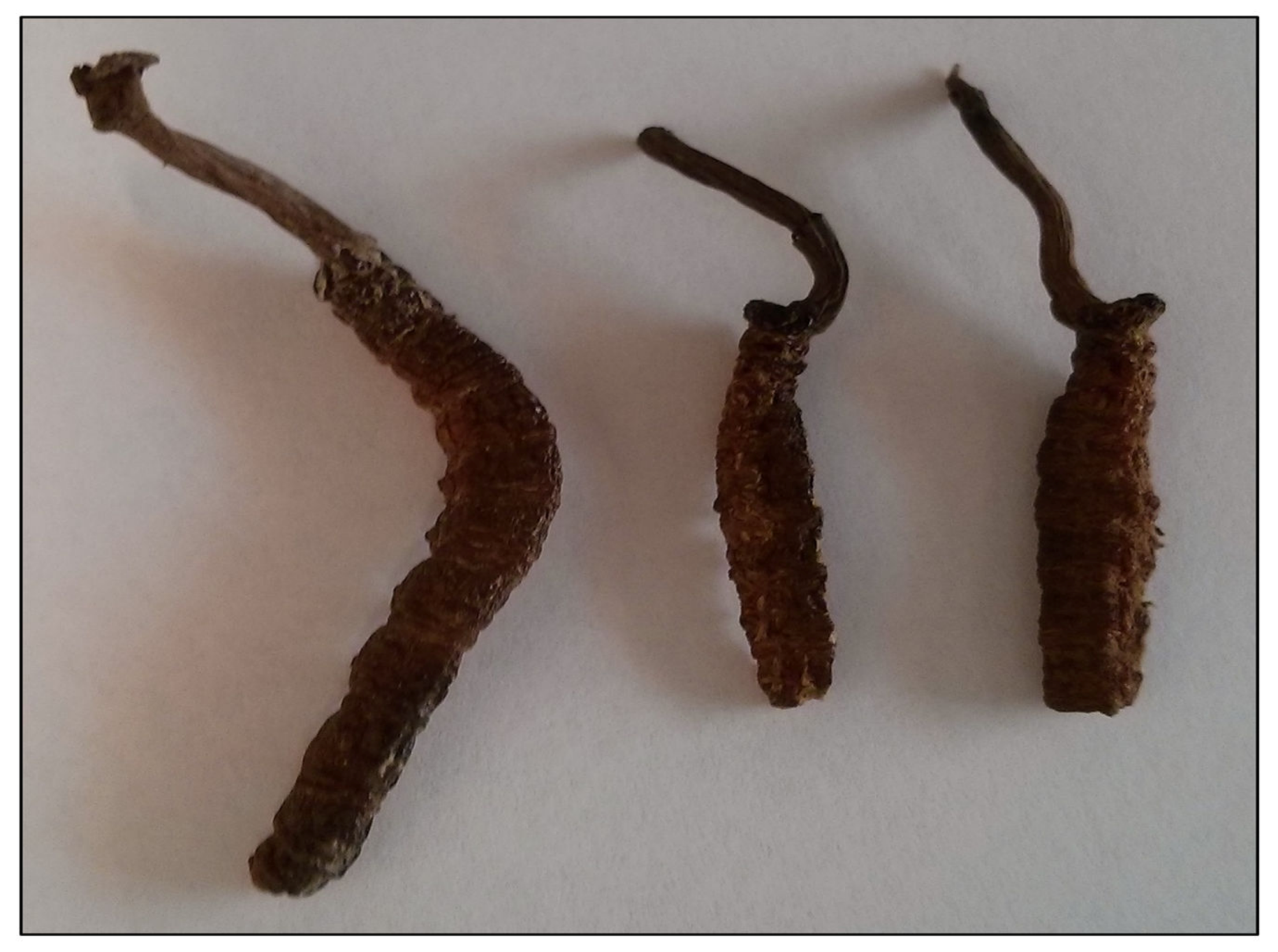
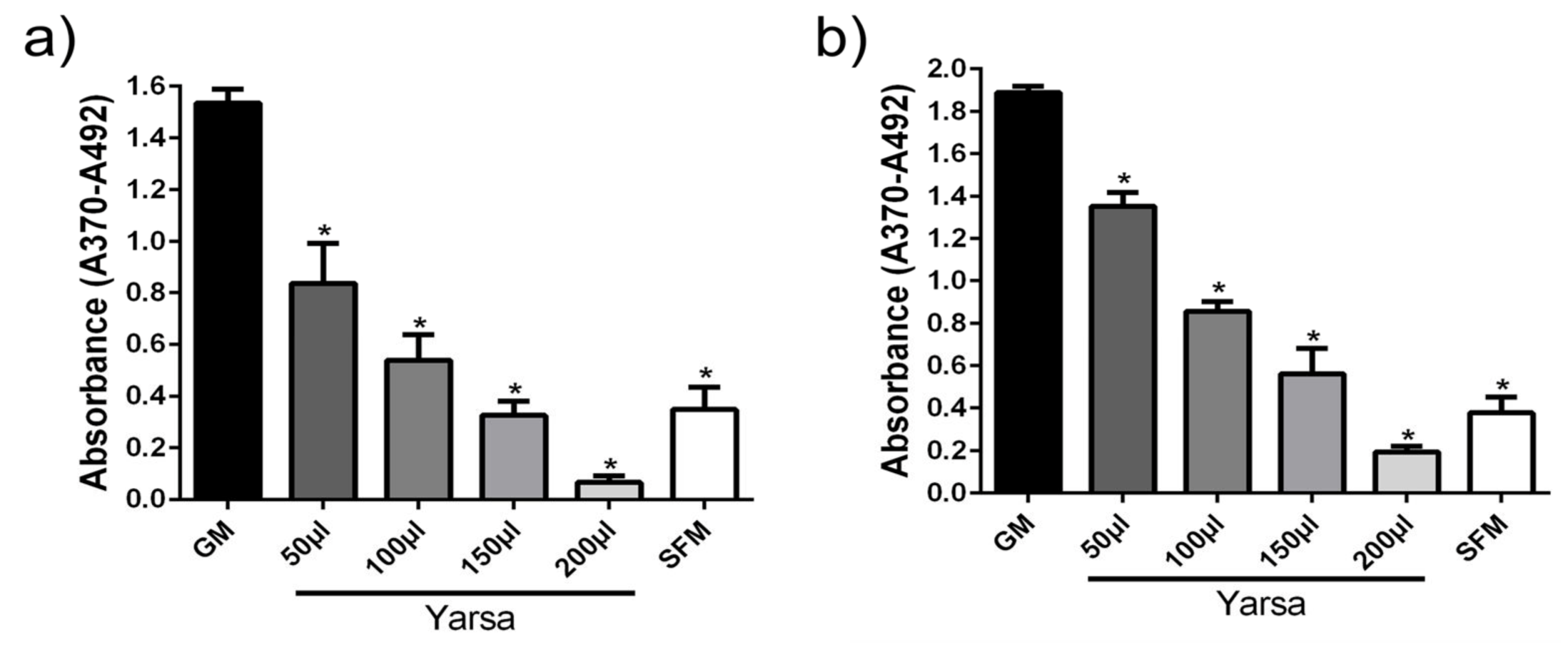

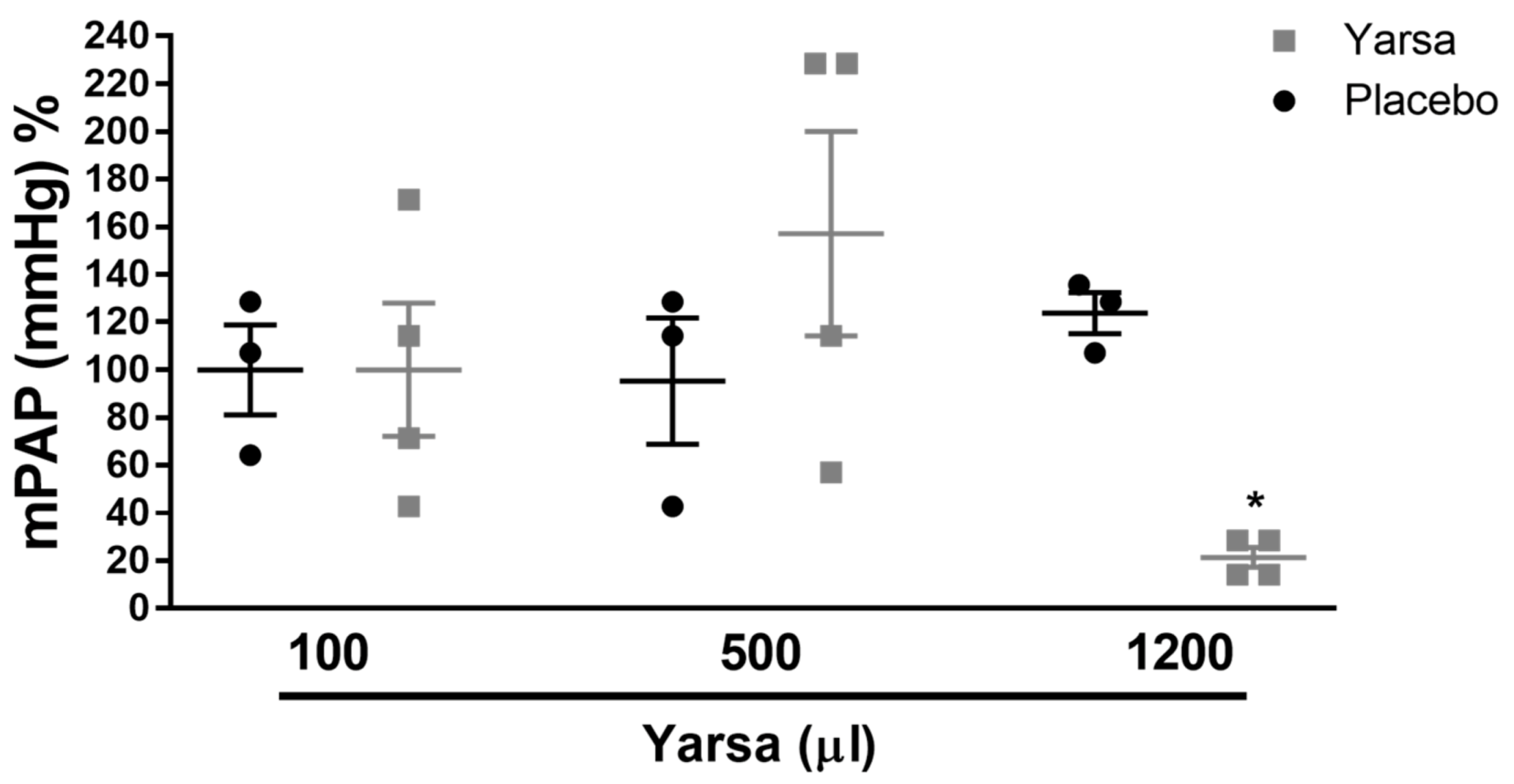
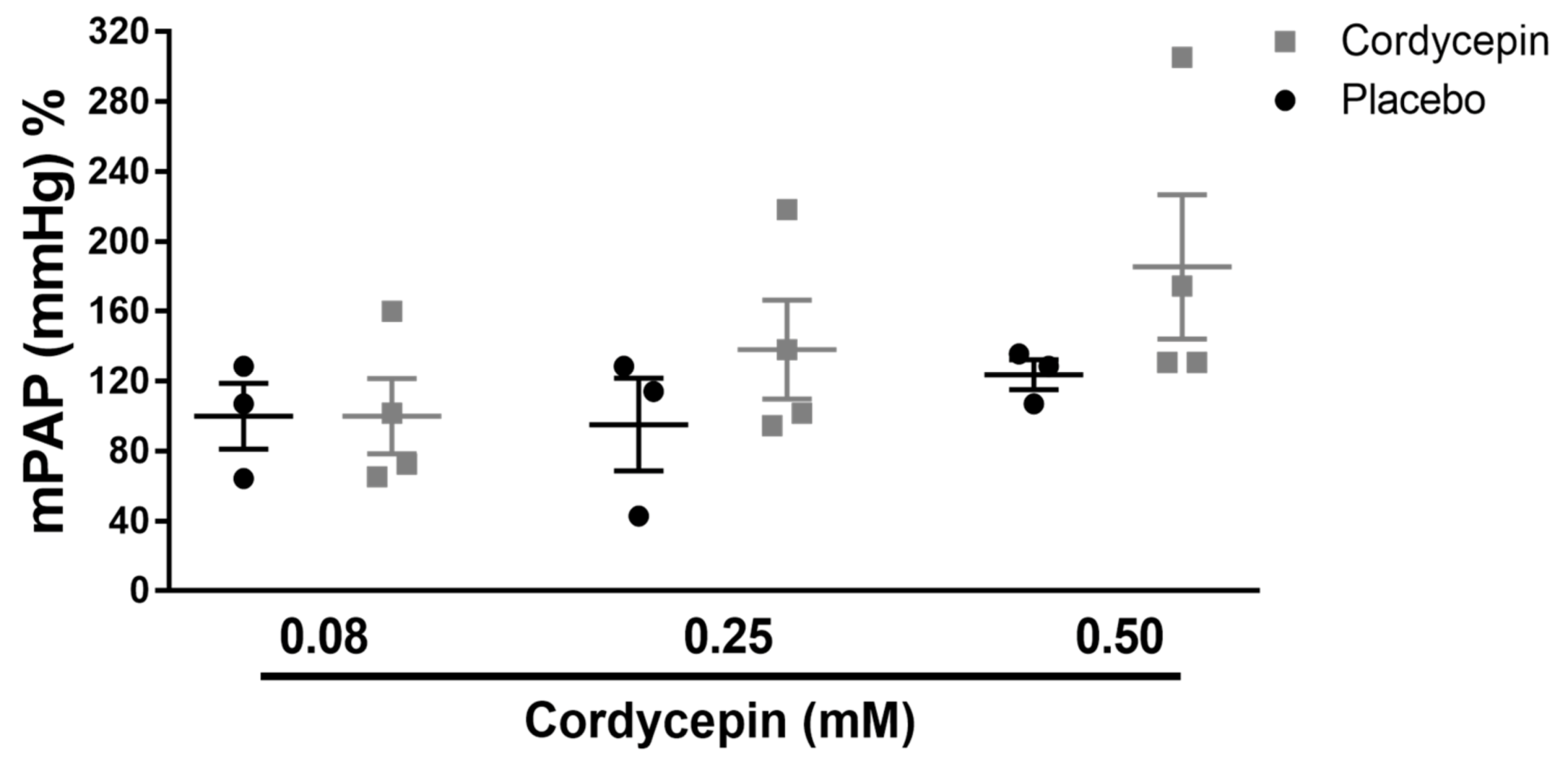
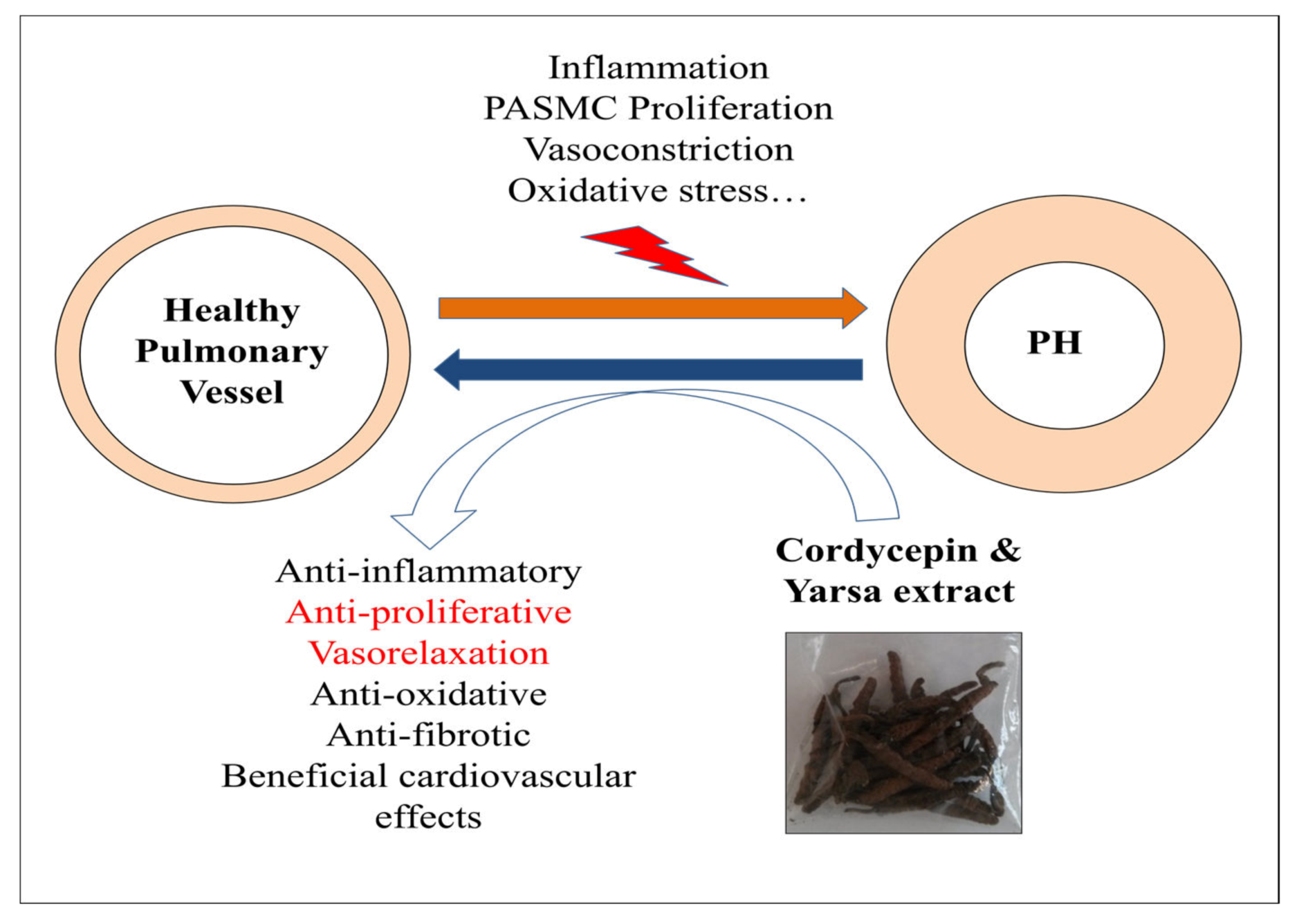
© 2020 by the authors. Licensee MDPI, Basel, Switzerland. This article is an open access article distributed under the terms and conditions of the Creative Commons Attribution (CC BY) license (http://creativecommons.org/licenses/by/4.0/).
Share and Cite
Luitel, H.; Novoyatleva, T.; Sydykov, A.; Petrovic, A.; Mamazhakypov, A.; Devkota, B.; Wygrecka, M.; Ghofrani, H.A.; Avdeev, S.; Schermuly, R.T.; et al. Yarsagumba is a Promising Therapeutic Option for Treatment of Pulmonary Hypertension due to the Potent Anti-Proliferative and Vasorelaxant Properties. Medicina 2020, 56, 131. https://doi.org/10.3390/medicina56030131
Luitel H, Novoyatleva T, Sydykov A, Petrovic A, Mamazhakypov A, Devkota B, Wygrecka M, Ghofrani HA, Avdeev S, Schermuly RT, et al. Yarsagumba is a Promising Therapeutic Option for Treatment of Pulmonary Hypertension due to the Potent Anti-Proliferative and Vasorelaxant Properties. Medicina. 2020; 56(3):131. https://doi.org/10.3390/medicina56030131
Chicago/Turabian StyleLuitel, Himal, Tatyana Novoyatleva, Akylbek Sydykov, Aleksandar Petrovic, Argen Mamazhakypov, Bhuminand Devkota, Malgorzata Wygrecka, Hossein Ardeschir Ghofrani, Sergey Avdeev, Ralph Theo Schermuly, and et al. 2020. "Yarsagumba is a Promising Therapeutic Option for Treatment of Pulmonary Hypertension due to the Potent Anti-Proliferative and Vasorelaxant Properties" Medicina 56, no. 3: 131. https://doi.org/10.3390/medicina56030131
APA StyleLuitel, H., Novoyatleva, T., Sydykov, A., Petrovic, A., Mamazhakypov, A., Devkota, B., Wygrecka, M., Ghofrani, H. A., Avdeev, S., Schermuly, R. T., & Kosanovic, D. (2020). Yarsagumba is a Promising Therapeutic Option for Treatment of Pulmonary Hypertension due to the Potent Anti-Proliferative and Vasorelaxant Properties. Medicina, 56(3), 131. https://doi.org/10.3390/medicina56030131







